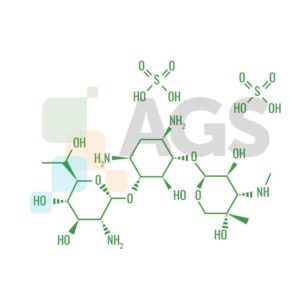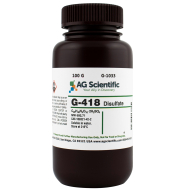For over 20 years, AG Scientific has been a leading supplier of G-418 (Geneticin). Our success with a combination of fermentation and synthesis has allowed us to build a catalog of over 200 antibiotics and a customer base of researchers, catalog biochemical distributors and cell media manufacturers worldwide. AG Scientific offers a full range of G-418 services, including custom bottling, sterile formulations, custom packaging, as well as a full suite of private labeling capabilities. We can confidently state that our supply is uninterrupted, prices are stable, and we stand ready to respond promptly to your specific bulk requirements.
About G-418 Sulfate
G-418 Sulfate (also known commercially as Geneticin) is an aminoglycoside antibiotic that is synthesized from Micromonospora rhodorangea and functions by causing a chain of nonsense mutations during translation. Due to translation G-418 inhibited polypeptide synthesis and protein elongation. G-418 binds to the 80S subunit of the ribosome by blocking the elongation phase of protein synthesis, both in prokaryotic and eukaryotic cells. It also shows activity against protozoa, cecal amoebiasis, and helminths.Chemical Data
| Chemical Formula: | C20H40O10N4 • 2H2SO4 |
| CAS Number: | 108321-42-2 |
| Molecular Weight: | 692.7 Da |
| Appearance: | White to off-white powder |
| Purity: | ≥92% |
Applications
- Used routinely in molecular genetics experiments for selecting eukaryotic transformants
- Used in plant and mammalian cell culture as a selectable marker
- Used as a gene selection antibiotic that has a powerful new role in genome editing, utilizing the CRISPR/CAS9 system.
- Ability to inhibit poliovirus and rhinovirus 2A proteinases in vitro
Frequently Asked Questions
What types of cells does G-418 work with?
G-418 inhibits protein synthesis in prokaryotic and eukaryotic cells. It is toxic to bacteria, yeast, protozoans, higher plant, and mammalian cells.What is the working concentration for selection?
The working concentration for the purpose of selection varies with cell type, media, growth conditions and cell metabolic rate. Below are recommended G418 concentrations based on cell type.| Selection: | Recommended Concentrations: |
| Resistant cells | 10-2000 mg/mL |
| Mammalian cells | 100-2000 ug/mL |
| Plant Cells | 10-100 ug/mL |
| Yeast | 500-1000 ug/mL |
| Dictyostelium amoebae | 10-100 mu/mL |
Is G-418 the same as Geneticin?
G-418 and Geneticin have the same chemical structure. G-418 is the generic chemical while Geneticin is a registered trademark brand of LifeTech Corporation.
What is the potency specification for G-418 liquid and powder?
The potency specification is >700 ug/mg. Small lot-to-lot variances do occur.What gene confers resistance to G-418?
The neo/kan gene confers resistance this antibiotic. This gene allows production of aminoglycoside 3-phosphotransferase, which inactivates G-418, neomycin, and kanamycin via phosphorylation.
How can non-transfected cells escape antibiotic selection?
Cells can escape selection if the antibiotic is used at a very low concentration or if the cell density on the plate is too high. Additionally, cells rapidly proliferating are killed faster than those only slowly proliferating. Control cells should die within 5-7 days after addition of the antibiotic allowing colonies of resistant cells to form by 10-14 days.
Can mammalian cells in culture divide in the presence of G-418?
Yes, cells can continue to divide up to two times in the presence of lethal doses of the antibiotic. The effect of the product usually becomes apparent within two days.
How to I calculate for the desired liquid potency of this product?
Potency is reported in µg/mg. To convert the potency reported on the powder to liquid potency, divide the potency by 1000 and multiply this by the desired potency. For example: If the potency reported on the powder is 750 ug/mg and you wish to make a solution of 400 mg/mL you would: 1000/750 x 400 mg/mL = 533.33 mg/mL
Recommendation:
We recommend setting a dose response curve for both sensitive and resistant mammalian cells. Refer to the Certificate of Analysis under ED50 Sensitive and ED50 Resistant for suitable concentrations of G-418 to use for the curve. These concentrations are reported as dry weight. G418 is most effective against dividing cells. By permitting cell growth prior to the addition of G418, one will maximize the selection characteristics of the antibiotic for both sensitive and resistant cells.
G418 Resistant Cell Line Procedure
To generate a stable cell line expressing your protein of interest, you need to determine the minimum concentration of antibiotic required to kill your untransfected host cell line. Test a range of concentrations (at least 6) to ensure that you determine the minimum concentration necessary for your cell line.- Seed cells at approximately 20-25% confluency on the appropriate number of plates for each time plate and allow cells to adhere overnight. For cells that require higher densities for viability, increase the number of cells seeded.
- The next day, substitute culture medium with medium containing varying concentrations of the antibiotic (i.e., test 0, 50, 100, 200, 400, 800, 1000 ug/mL).
- Replenish the selective medium every 3-4 days.
- Count the number of viable cells at regular intervals to determine that appropriate concentration of antibiotic that prevents the growth of untransfected cells. Select the concentration that kills the majority of the cells in the desired number of days, generally 7-10 day.
Stock Solution Guideline:
The general guideline is 400 µg/mL for selection and 200 µg/mL for maintenance are required for mammalian cells. Plant cells require 25-50 µg/mL for selection and 10 µg/mL for maintenance and bacteria 8-16 µg/mL for selection.
Using an analytical balance, weigh an appropriate amount of G-418 powder (use formula below). Reconstitute aseptically by adding the powder to distilled water (pH 5.6 to 7.0) to the desired concentration and sterile filter. Required weight (mg) = Desired Volume (mL) x [Desired Concentration (µg/mL) / Lot Potency (µg/mg)]
NOTE: For G418, units/mg is exchangeable with µg/mg. Potency is always measured against a reference by the inhibition ring method. The inhibitory effect was measured on B. subtilis ATCC 6633.
How do I perform a Dose-Response curve of G-418 solution in HEPES buffer?
The outcome of this protocol is to produce a solution of G418 and HEPES in the concentration of 500 mg of active G418 to 1 ml of HEPES.
- Find the active percentage of G418 as labeled on the vial by the producer (example 760 mg active per g or 76 percent active)
- Mass the G418 in the vial and calculate the amount active G418 present (example mass of 1.178 mg with 76% active is: 1.178 mg x 0.76 = .89528 g active)
- Determine the quantity of HEPES to be used by, dividing the amount of active G418 (in mg) by 500. This is the volume in ml of HEPES that needs to be used to generate the desired concentration (example 895.28 mg G418 / 500 = 1.79 ml of HEPES)
- Prepare the solution in a 15 mL tube, filter and aliquot into microtubes in portions of no less the 500 microliters.
- Store at 20ºC. Then thaw and add G-418 at the appropriate concentration. The drug loses activity after one week, make new media with fresh drug as needed.

